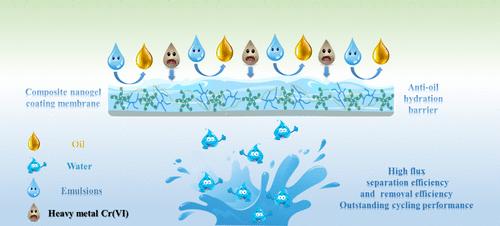当前位置:
X-MOL 学术
›
Ind. Eng. Chem. Res.
›
论文详情
Our official English website, www.x-mol.net, welcomes your
feedback! (Note: you will need to create a separate account there.)
Ultrathin and Metal Ions-Free Polyionic Nanogel Coating Membrane for Efficient and Fast Oil-in-Water Emulsions Separation and Cr(VI) Removal: Adsorption Properties, Kinetics, and Mechanism
Industrial & Engineering Chemistry Research ( IF 3.8 ) Pub Date : 2024-07-19 , DOI: 10.1021/acs.iecr.4c01873 Wenjie Luo 1 , Yijian Zheng 1 , Xuan Long 1 , Rongtong Wang 1 , Yuanhang Pi 1 , Feipeng Jiao 1
Industrial & Engineering Chemistry Research ( IF 3.8 ) Pub Date : 2024-07-19 , DOI: 10.1021/acs.iecr.4c01873 Wenjie Luo 1 , Yijian Zheng 1 , Xuan Long 1 , Rongtong Wang 1 , Yuanhang Pi 1 , Feipeng Jiao 1
Affiliation

|
The problem of oil fouling and the complex composition of oily wastewater are bottlenecks that urgently need to be addressed for the application of membrane separation technology in the field of oil–water separation. Therefore, ultrathin TA/SA/PEI polyionic nanogel coatings were constructed on hydrophobic PVDF membrane surfaces through surface grafting and dopamine-like self-polymerization reactions. The functional coated membranes (TSP-3) retain superhydrophilicity and underwater superoleophobicity, even in harsh environments such as strong acids, strong alkalis, various salt solutions, ultrasound, and abrasion. The TSP-3 membrane exhibited excellent separation efficiency (>99%) for a wide range of oil-in-water emulsions stabilized by surfactants, with virtually no deterioration in flux (>8014.70 ± 298.86 L·m–2·h–1·bar–1) over five dead-end cycle separations. The formation process of the oil film filter cake was also analyzed in crossflow mode. It was assumed that the accumulation of oil droplets on the membrane surface to form a film under certain conditions was beneficial to the membrane’s antioil fouling performance. Meanwhile, the TSP-3 membrane possessed high removal efficiency (96.13%) and recoverability for Cr(VI), and the phenolic hydroxyl groups could also reduce Cr(VI) to the lower toxicity Cr(III). Various adsorption kinetic and isotherm models were used to analyze the adsorption process, and the results fit well with the pseudo-second-order kinetic model (R2 = 0.99820) and the Langmuir model (R2 = 0.99986). This indicated that the adsorption of Cr(VI) by TSP-3 was monomolecular layer chemical adsorption on heterogeneous surfaces, and the adsorption was favorable (0 < RL < 1). Electrostatic attraction and hydrogen bonding were considered to play a key role in the adsorption of Cr(VI) by XPS characterization analysis and DFT theoretical calculations. This strategy provided a feasible approach for constructing ultrathin polyanionic nanogel membranes to achieve an antioil barrier, which could effectively and rapidly separate a wide range of oil-in-water emulsions stabilized by surfactants, while removing and reducing Cr(VI).
中文翻译:

用于高效快速水包油乳液分离和去除 Cr(VI) 的超薄且不含金属离子的聚离子纳米凝胶涂层膜:吸附特性、动力学和机理
油垢问题和含油废水成分复杂是膜分离技术在油水分离领域应用急需解决的瓶颈。因此,通过表面接枝和类多巴胺自聚合反应,在疏水性PVDF膜表面构建了超薄TA/SA/PEI聚离子纳米凝胶涂层。功能性涂层膜(TSP-3)即使在强酸、强碱、各种盐溶液、超声波、磨损等恶劣环境下也能保持超亲水性和水下超疏油性。 TSP-3 膜对表面活性剂稳定的各种水包油乳液表现出优异的分离效率 (>99%),且通量几乎没有恶化 (>8014.70 ± 298.86 L·m –2 ·h –1 · bar –1 ) 超过五次死端循环分离。还以横流模式分析了油膜滤饼的形成过程。认为在一定条件下油滴在膜表面积累形成薄膜有利于膜的抗油污性能。同时,TSP-3膜对Cr(VI)具有较高的去除效率(96.13%)和可回收性,并且酚羟基还可以将Cr(VI)还原为毒性较低的Cr(III)。采用各种吸附动力学和等温线模型对吸附过程进行分析,结果与准二级动力学模型(R 2 = 0.99820)和Langmuir模型(R 2 = 0.99986)很好地吻合。 这表明TSP-3对Cr(VI)的吸附是异质表面上的单分子层化学吸附,且吸附效果良好(0 < R L < 1)。通过XPS表征分析和DFT理论计算,认为静电引力和氢键在Cr(VI)的吸附中起关键作用。该策略为构建超薄聚阴离子纳米凝胶膜以实现抗油屏障提供了可行的方法,该膜可以有效、快速地分离各种表面活性剂稳定的水包油乳液,同时去除和还原Cr(VI)。
更新日期:2024-07-19
中文翻译:

用于高效快速水包油乳液分离和去除 Cr(VI) 的超薄且不含金属离子的聚离子纳米凝胶涂层膜:吸附特性、动力学和机理
油垢问题和含油废水成分复杂是膜分离技术在油水分离领域应用急需解决的瓶颈。因此,通过表面接枝和类多巴胺自聚合反应,在疏水性PVDF膜表面构建了超薄TA/SA/PEI聚离子纳米凝胶涂层。功能性涂层膜(TSP-3)即使在强酸、强碱、各种盐溶液、超声波、磨损等恶劣环境下也能保持超亲水性和水下超疏油性。 TSP-3 膜对表面活性剂稳定的各种水包油乳液表现出优异的分离效率 (>99%),且通量几乎没有恶化 (>8014.70 ± 298.86 L·m –2 ·h –1 · bar –1 ) 超过五次死端循环分离。还以横流模式分析了油膜滤饼的形成过程。认为在一定条件下油滴在膜表面积累形成薄膜有利于膜的抗油污性能。同时,TSP-3膜对Cr(VI)具有较高的去除效率(96.13%)和可回收性,并且酚羟基还可以将Cr(VI)还原为毒性较低的Cr(III)。采用各种吸附动力学和等温线模型对吸附过程进行分析,结果与准二级动力学模型(R 2 = 0.99820)和Langmuir模型(R 2 = 0.99986)很好地吻合。 这表明TSP-3对Cr(VI)的吸附是异质表面上的单分子层化学吸附,且吸附效果良好(0 < R L < 1)。通过XPS表征分析和DFT理论计算,认为静电引力和氢键在Cr(VI)的吸附中起关键作用。该策略为构建超薄聚阴离子纳米凝胶膜以实现抗油屏障提供了可行的方法,该膜可以有效、快速地分离各种表面活性剂稳定的水包油乳液,同时去除和还原Cr(VI)。











































 京公网安备 11010802027423号
京公网安备 11010802027423号